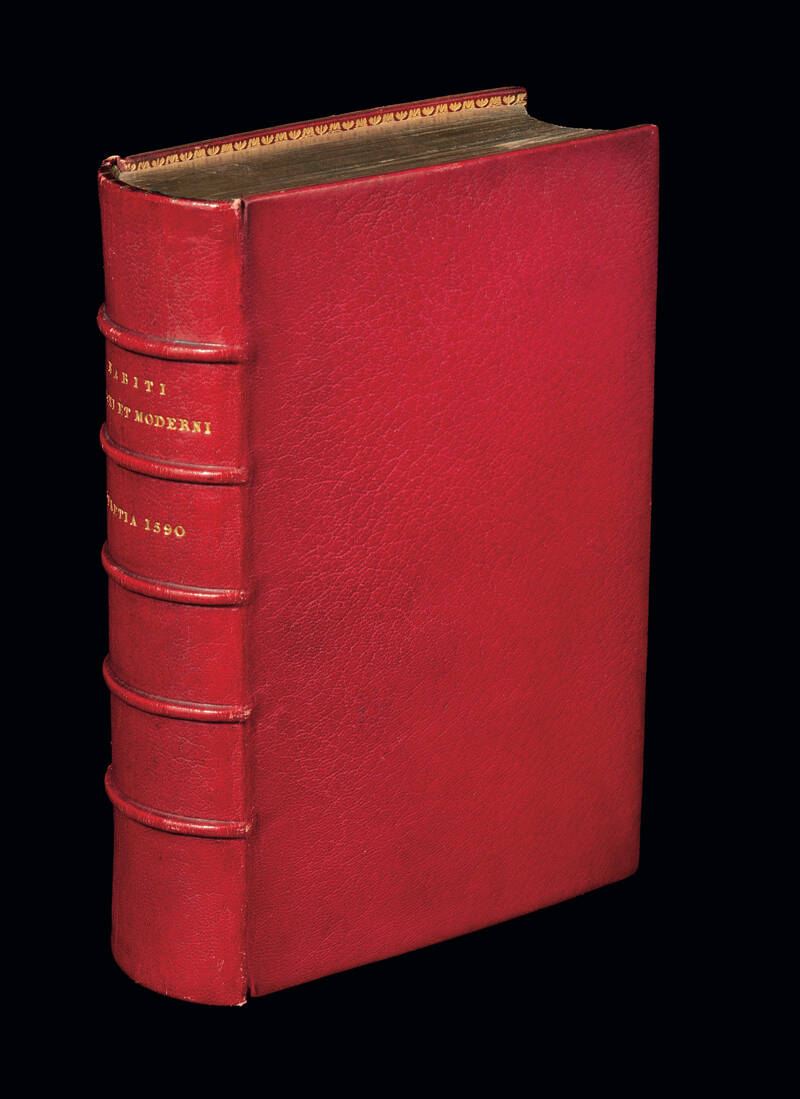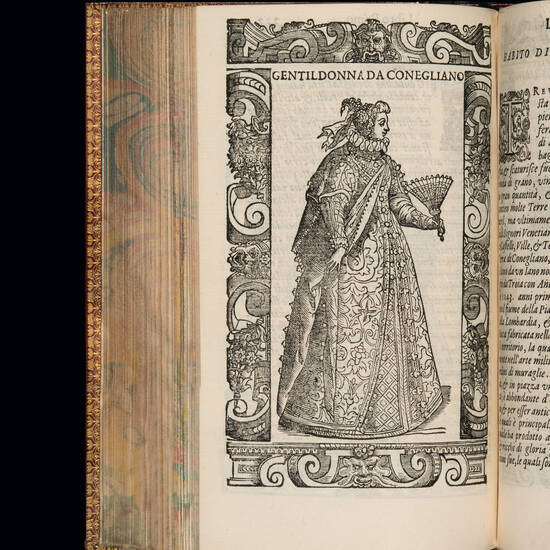VECELLIO, Cesare. Degli Habiti Antichi, et Moderni di Diverse Parti del Mondo Libri due, fatti da Cesare Vecellio, & con Discorsi da Lui Dichiarati.
Venice, Damian Zenaro., 1590.Octavo (181x106 mm), [24], 499 leaves. Elaborate woodcut title-page border in the form of a cartouche, with allegorical figures of America, Asia, Africa and Europe at each of the four corners, 412 full-page woodcuts of costumes and two section titles set within 4-parts ornamental borders, five full-page woodcut views of Venice, one emblematic woodcut tondo within a ruled frame set on a full page, numerous woodcut ornamental head- and tailpieces, decorative initials of varying sizes, and small printers' ornaments.. One small marginal restoratione on the first page of the preliminary leaves touching a few letters, lacking the final blank page; overall a very fine copy bound by Trautz-Bauzonnet in red morocco, gilt edges.
First edition of this rightly famous and influential costume book, enlivened by a set of over 400 woodcut illustrations of dress and clothing from various parts of the world, with a rich complementary explanatory text. Cesare Vecellio (1521ca.-1601), a cousin of the celebrated Venetian painter Titian and a member of his prestigious atelier, was active in Veneto as a painter for most of his lifetime. In his final years, he dedicated himself to the publication of this history of costume with encyclopedic ambitions, both in geographical and chronological terms, encompassing the whole world known at the time and stretching its gaze from the Old Testament and the Classical world to the Renaissance. The treatise is divided in two books, one devoted to Venice, Rome, Italy and Europe, the other dwelling on Asia and Africa (a set of illustrations on America had already been planned in 1590, but only appeared in the second edition of the work, dating from 1598). A detailed index of items and geographical places is given at the beginning of the work, to orient the reader. The work stands out for the richness and quality of information, collected on the basis of a great variety of sources ranging from classical books, early travel narratives, voyagers' reports, oral testimonies of ambassadors, traders, merchants, soldiers, and the works of art Vecellio encountered during his activity as a painter. Although part of the repertoire of images have been attributed to Cesare's cousin, Titian, all the drawings are most probably the author's work. With his Habiti antichi et moderni, Vecellio renovated the genre of costume book, which had enjoyed enormous success all along the XVI century, as a result of the widening of geographical and cultural horizons that followed the discovery of the New Worlds. Differently from his Italian and European forerunners, Vecellio decided to accompany each illustration with a thorough description and a rich commentary on the subject represented: in this way, far from being a simple catalogue of particular ways of dressing, aiming at satisfying the reader's curiosity, the collection becomes an opportunity for broader reflection on the implications of clothing on society and on its relations to the cultural and political history of the part of the world each time concerned. Therefore, due to the special attention accorded to Venice and Italy in the first book, the Habiti antichi et moderni provides also an original insight into contemporary Venetian and Italian societies, which are not devoid of political vibrations. In Vecellio's reading, since rulers are those mainly responsible for changes in fashion, the extraordinary variety of XVI century Italian clothing is a direct consequence of Italian history, and of the political fragmentation and instability of the Peninsular states in particular. On a more general level, ‘through the lens of the iconographic reproduction of dress and the text accompanying it, Vecellio's book opens a window onto the complexity of Italian and European Renaissance culture. Illustrating how fashion is linked to both individual and collective history, Vecellio's Habiti can be considered a precursor to modern ethnographic research' (E. Paulicelli, Mapping the World…).
Guérin Dalle Mese, Abiti di Cesare Vecellio: Venezia e “il Veneto”, in T. Conte (ed.), Cesare Vecellio, 1521c.-1601, 2001, p. 125-154; E. Paulicelli, Mapping the World. Dress in Cesare Vecellio's costume books, in G. Riello, P. McNeil (ed.), The Fashion History Reader. Global Perspectives, Routledge 2010.

